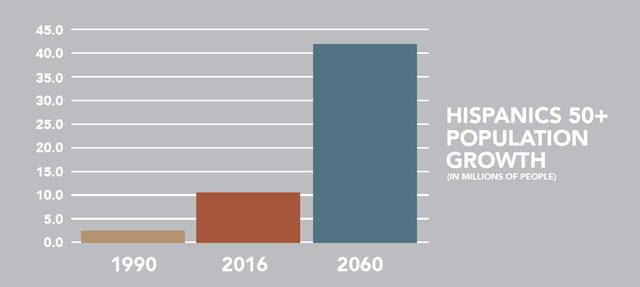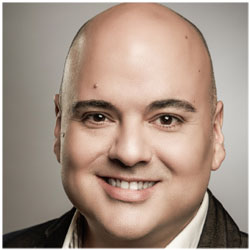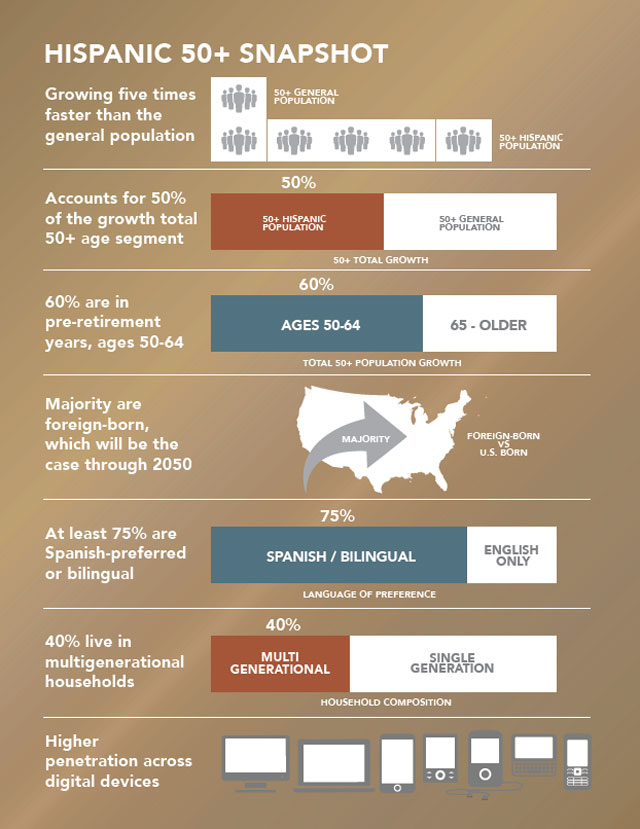What is the mindset of Latinos 50+ these days? Could they be living lives in frank contradiction to many varying misconceptions of the recent past? Is this growing segment a change agent, breaking molds and structures in our economy and society?
By Louis Maldonado – Partner, Managing Director at d expósito & Partners
Being the Hispanic ad agency of record of AARP, the
iconic organization for the 50+, has granted us a front seat, privileged, individualized and enhanced proximity to the 50+ as the segment seems to continue a path of vibrancy and self-fashioning. Previously accepted notions of aging the old-fashioned way and nearly “absolute truths” of the past have been forever cracked or have disappeared to give way to an excitingly new modernity in behavior of the 50+. All of a sudden, it is cool to be 50+. And nowhere is this more prevalent than among U.S. Hispanics where new perceptions of change are taking hold, and while there is a level of insecurity among them, it is consistently trumped by a certainty of opportunity.
The majority in this segment are Hispanic Baby Boomers. Many of us at d expósito & Partners have been studying them and crafting communications to engage them for much of our careers. Twenty years ago this audience was in a very different life stage: they were raising families and aspiring to create a better life for their children. They were working and saving with the hopes of buying a home, helping their kids get an education, proudly funding quinceañeras and weddings, and gradually realizing a stable and secure financial future.
 Now, Latinos 50+ are in a different life stage, or are they? Most are now in their pre-retirement years, but they are still working hard to help their families get ahead. Forty percent live in multigenerational households, to which they contribute financially and help with child-rearing. The other 60% still have family responsibilities, not only supporting their children and helping raise their grandchildren, but many are also caring for a more mature loved-one with ailing health. Most of them are doing so while facing the reality that their own endurance will gradually decrease, but they are more aware and conscious now about keeping healthy and in shape, especially because their bodies may begin to show that they are not as agile as they once were. While the average household income for 50+ Hispanics is on the rise, many are still striving to ensure a secure financial future after being disproportionately affected by the Great Recession. They are helping their families pay for the cost of education and healthcare. Regardless of individual circumstances, as a collective, Hispanics 50+ persevere for long-existing cultural reasons and motivators. In essence, because to them, family is central and a driving motivator to much of their decision making process in life.
Now, Latinos 50+ are in a different life stage, or are they? Most are now in their pre-retirement years, but they are still working hard to help their families get ahead. Forty percent live in multigenerational households, to which they contribute financially and help with child-rearing. The other 60% still have family responsibilities, not only supporting their children and helping raise their grandchildren, but many are also caring for a more mature loved-one with ailing health. Most of them are doing so while facing the reality that their own endurance will gradually decrease, but they are more aware and conscious now about keeping healthy and in shape, especially because their bodies may begin to show that they are not as agile as they once were. While the average household income for 50+ Hispanics is on the rise, many are still striving to ensure a secure financial future after being disproportionately affected by the Great Recession. They are helping their families pay for the cost of education and healthcare. Regardless of individual circumstances, as a collective, Hispanics 50+ persevere for long-existing cultural reasons and motivators. In essence, because to them, family is central and a driving motivator to much of their decision making process in life.
While creating a better life for their families is absolutely a particularly key driving motivator for 50+ Hispanics, they also realize the need to continue growing and evolving, personally. They have a desire to build their own legacies and to ensure their life’s work has a positive impact on their families for generations to come. With the majority being foreign-born and at least 75% being Spanish-preferred or bilingual, this includes a commitment to passing down strong Latino values and traditions among their families. In turn, the younger members of the family often offer encouragement and support so that the 50+ can continue growing, evolving and pursuing their dreams.
With the wisdom of life experience, and with higher adoption of all things digital than their non-Hispanic counterparts, they know they still bring value and have the power to make a difference. They know they can shape key issues and trends in mainstream society. Perhaps what they need most is a measure of meaningful encouragement and some supportive advice that will help them feel secure in knowing the proper steps to take. Many times, this comes from loved-ones. However, this offers a real opportunity for brands to also step in and provide information and guidance to fulfill a much-needed helping hand. AARP is fulfilling an exemplary role in this regard.
Opportunity Abounds
Twenty-five years ago, the 50+ segment of the Hispanic Market was relatively small, at just 2 million people in 1990, when the U.S. Census first tracked the Hispanic population. Today, at nearly 11 million strong, the 50+ Hispanic segment is the fastest growing of the Hispanic Market. It accounts for 50% of the total 50+ segment growth and will quadruple in size by 2060, from 10.5 million to 42.1 million.

Aside from the growth in numbers, this segment has also experienced a 32% increase in households with incomes earning over $75,000, since the year 2000. Contrary to popular opinion, they are exceptionally savvy in all things digital and, curiously, less averse to brand messages evidenced by lower use of ad blockers. Needless to say, they have had an impact on both a micro and a macro level in society, greatly contributing to what we call the New America. These are all clear markers of a desirable consumer prospect, and these are some categories where the Hispanic 50+ audience may rightly present a particular opportunity:
Financial Planning – As mentioned previously, household income for the Hispanic 50+ is on the rise, but so is the concern over the need for financial security. There is a greater need for information and guidance on matters related to savings, life insurance and how to go about investing for a stable future; matters which most Latinos would say they need to reach outside their circle of family and friends, as they perhaps may require seeking a qualified, trusted advisor. This is a relatively untapped opportunity for banks and other financial institutions that offer products, tools and consultation on developing personal wealth.
Healthcare – According to AARP’s own research, the large majority of Hispanics 50+ have access to health insurance. CDC data shows that they suffer disproportionately from conditions related to cardiovascular disease, overweight/obesity and mental health. The good news, though, is that awareness of these conditions and their prevalence in the community is also on the rise. It can be said that Hispanics are becoming more proactive about taking preventative measures and seeking medical help. Although some Managed Care and Pharmaceutical advertisers have already tapped into these trends, many have yet to seize this opportunity for business growth.
Family and Elder Care – Caring for a parent or other member of the family is a role that touches 50+ Hispanics 25% more than their non-Hispanic contemporaries. As a result of their ingrained cultural values, this is a distinct role they have long expected to fill and one that is embraced as a fulfilling, true and genuine, nearly organic, act of love. But still, half of Hispanic caregivers are in high need situations, and, as a result, they spend more time caring for their loved-ones than do non-Hispanics (32.1 hours vs. 21.1 hours) and are more likely to have made a major workforce change. Hispanic caregivers need the assistance of trusted in-home care providers that are competent in the lifestyle and culture of the Hispanic community. Although several providers seem to be invested in marketing for the General Market audience, the Hispanic Market remains an untapped opportunity for this category.
Higher Education and Professional Development – From 2007 to 2013, the 45+ age segment of the Hispanic civilian labor force increased by 33%, compared to just 6% for non-Hispanic 45+ participation. Interestingly, the Hispanic 45-54 age segment grew 27% compared to a 7% decline in non-Hispanic participation, driven by a 10% drop in the non-Hispanic White population. Many in the general 50+ population are experiencing the desire and/or need to continue working during their more mature years, and this is particularly profound with Hispanics 50+. Furthermore, Hispanics realize the need to continue developing and learning new job skills in order to remain competitive, particularly given the impact of evolving technology in our new economy. This presents an opportunity for institutions of higher learning and professional development.
The Next Wave of 50+ Hispanics: Gen X
As unbelievable as it may sound, the first Gen Xers turned 50 last year. Like non-Hispanic Gen Xers – and many Boomers for that matter – their top concerns about aging are directly related to their general health and financial security. They are thinking about the future, with the desire to stay physically and mentally fit and have enough income and savings to retire. Concerns that are particularly worrisome with Hispanic Gen Xers include the ability to pay for healthcare, always have a job, and the risk of encountering age discrimination in the workplace at their age.
Times are changing, and there appear to be new rules that govern the way we work, communicate and plan for the future. But Latino Gen Xers have lived enough to have faced uncertainty before, and they are known for their resiliency. The majority are either immigrants or of an immigrant family, so they have been exposed to the struggles that come with making progress in a new country. As children, they faced the fearful realities of the Cold War and the global threat of nuclear weapons. They entered adulthood and their working years in the midst of the recession of the early 90s, only to be hit again by the Great Recession and the sad era of rampant foreclosures. These life experiences are sufficient to make anyone cynical, a descriptor often used for Gen Xers, but Latino Gen Xers tend to be a bit more optimistic and hopeful. They have seen their families overcome adversity. They have overcome life’s hurdles before, themselves, and they know they have the support of family and their community to help them get through tough times.
Latino Gen Xers are even more likely than Boomers to agree that they are not going to be defined by their age and are more steeped in all things digital, to cite just one important example of their connectivity, awareness and readiness. Although they admit to needing guidance, they have a better sense of areas where they need to plan and do better; areas like health management and maintaining a healthy diet, setting personal goals for the future, financial education/planning and learning more about retirement alternatives. Although optimistic about their future, they have voiced a particular need in learning how to continue evolving and progressing in life, like financing education for their children and grandchildren, learning ways to acquire new job skills and starting their own businesses, new jobs or careers as acts of reinvention.
Everything Familiar Is New Again
Like the old Broadway tune, “everything old is new again.” With the 50+ target certainly far from feeling “old”, a new growth market segment has found its emergence. While many Hispanic marketers may have engaged these same individuals over the past 20-30 years, the varying challenges and opportunities faced at this life stage make Hispanics 50+ an even more defined and alluring, new growth opportunity. They are the fastest-growing segment of the 50+ population, one that is becoming increasingly multicultural with each passing generation. They are at the forefront of many issues shaping life at 50+, and they are eager for information and advice in areas critical to living a happy and healthy life. This presents viable business opportunities and sources of revenue growth, but to successfully win their loyalty marketers need to first understand their unique needs and develop products, services and marketing strategies of relevance that resonate with them organically. AARP keenly saw the rapidly changing demographics of the 50+ segment and realized that engaging Hispanics 50+ with relevant programs, services and benefits would be critical to carrying out its social mission and having its member base reflect the diversity of the New America. Many companies would benefit from studying AARP’s modelic role in society and their commitment to engaging multicultural audiences, like Hispanics. Long-term commitment is required, and it works.
Sources:
Caregiving in the U.S.: A Focused Look at Caregivers of Adults Age 50+, National Alliance for Caregiving and AARP Public Policy Institute, June 2015
AARP Health Care Costs in Retirement: A Survey among Non-retired Hispanic/Latino Adults, 2014; AARP Healthcare Costs Survey, 2013
U.S. Bureau of Labor Statistics, “Employment Status of the Civilian Noninstitutional Population”, detailed age, sex, and detailed Hispanic or Latino and Non-Hispanic ethnicity, Annual Averages, 2007 to 2013”
SBA Office of Advocacy Issue Brief Number 2, “Demographic Characteristics of Business Owners”, January 16, 2016
U.S. Census Bureau 2014 National Population Projections, Table 1. Projected Population by Single Year of Age, Sex, Race, and Hispanic Origin for the United States: 2014 to 2060
Louis Maldonado is partner at d expósito & Partners, LLC, where he supervises the AARP account. Maldonado earned an MBA from Indiana University with concentrations in Marketing and International Business, after graduating Cum Laude from Baldwin-Wallace College with a B.A. in Business Administration. He has guest lectured at Columbia University, NYU and Indiana University’s Kelley School of Business, among others.
d expósito & Partners, LLC produces White Papers, Opinion Pieces, and in-depth Articles on the varied, multi-layered experience of the U.S. Hispanic Market and its dynamic role within The New America, an inspiring term that the agency has trademarked in the form of its moniker, The New American Agency™.




